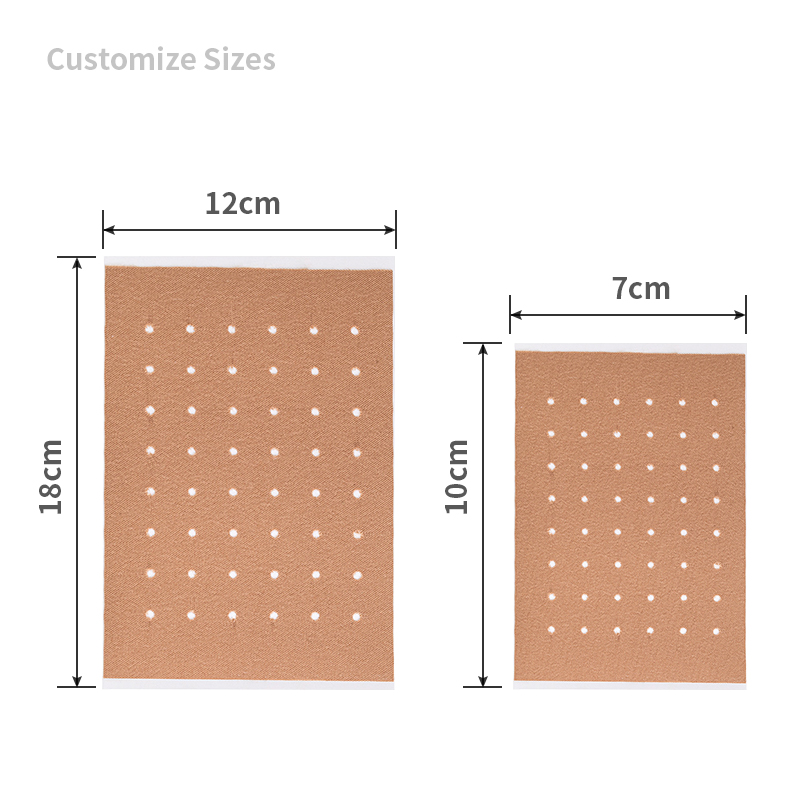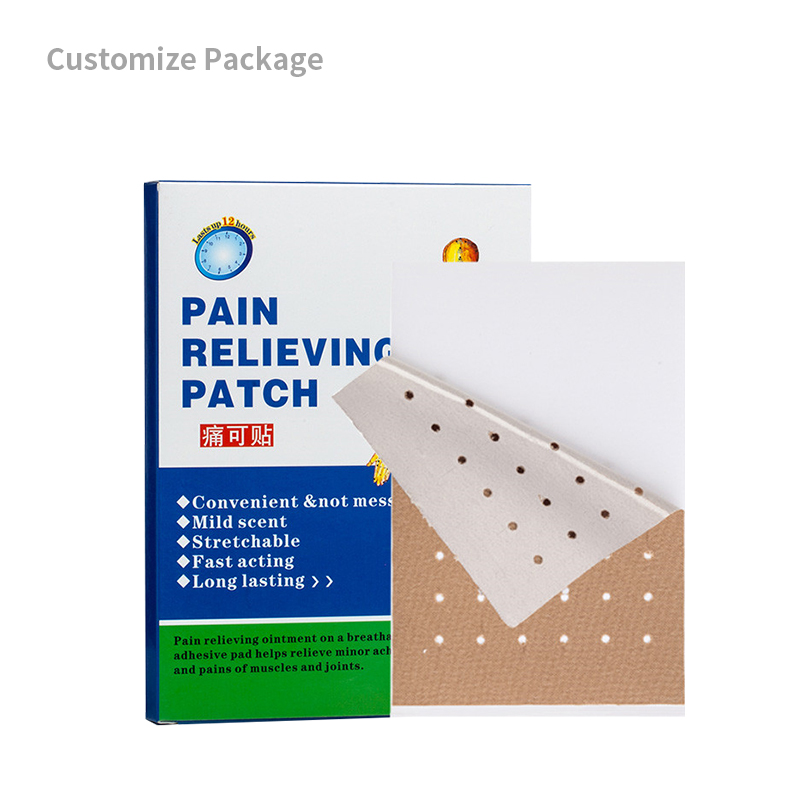Key Trends in Herbal Pain Relief Patches OEM Manufacturing
The herbal pain relief market is rapidly evolving, driven by increasing consumer demand for natural and effective solutions. This growth has led to significant developments in Herbal Pain Relief Patches OEM Manufacturing, with manufacturers striving to innovate and stay ahead of the competition. Understanding these key trends can help businesses make informed decisions when partnering with a Herbal Pain Relief Patches Manufacturer. This article explores the most important trends shaping the industry, from ingredient innovation to sustainable practices, and how they impact the market.

1. Increased Focus on Natural and Organic Ingredients
Consumer Demand for Natural Solutions
One of the most significant trends in Herbal Pain Relief Patches OEM Manufacturing is the increased focus on natural and organic ingredients. Consumers are becoming more health-conscious and are actively seeking products that are free from synthetic chemicals and artificial additives. As a result, manufacturers are sourcing high-quality herbal ingredients that are both effective and safe.
Certified Organic Products
Herbal Pain Relief Patches Manufacturers are responding to this trend by offering products that are certified organic. These certifications not only meet consumer demand but also enhance brand credibility and marketability. Private Label Herbal Pain Relief Patches with organic certifications are particularly appealing to consumers who prioritize natural health solutions.
2. Advancements in Patch Technology
Improved Adhesive Formulations
The technology behind herbal pain relief patches has seen significant advancements in recent years. One key area of innovation is in adhesive formulations. Herbal Pain Relief Patches OEMs are developing adhesives that are both skin-friendly and effective in delivering active ingredients over extended periods. These new formulations ensure that patches remain in place during daily activities without causing skin irritation.
Enhanced Transdermal Delivery Systems
Another critical development is the improvement of transdermal delivery systems. Custom Herbal Pain Relief Patches are now being designed to enhance the absorption of active herbal ingredients through the skin. This ensures that the therapeutic effects are delivered more efficiently, providing faster and longer-lasting pain relief.
3. Customization and Personalization of Products
Tailored Herbal Blends
Customization is becoming increasingly important in the Herbal Pain Relief Patches industry. Businesses are looking for ways to differentiate their products, and one effective strategy is offering Custom Herbal Pain Relief Patches. OEMs are now providing options to tailor herbal blends according to specific consumer needs, such as targeting joint pain, muscle soreness, or chronic conditions.
Personalized Branding and Packaging
In addition to customized formulations, there is also a growing trend towards personalized branding and packaging. Private Label Herbal Pain Relief Patches allow businesses to create unique products that reflect their brand identity. Manufacturers are offering a wide range of packaging options, from eco-friendly materials to innovative designs that appeal to various consumer segments.
4. Sustainability and Ethical Manufacturing Practices
Eco-Friendly Production Processes
Sustainability is becoming a central focus in Herbal Pain Relief Patches OEM Manufacturing. Consumers are increasingly aware of the environmental impact of their purchases, and they expect brands to adopt eco-friendly practices. Manufacturers are responding by implementing sustainable production processes, such as reducing waste, minimizing energy consumption, and using biodegradable materials.
Ethical Sourcing of Ingredients
In addition to sustainable manufacturing, there is also a strong emphasis on ethical sourcing of herbal ingredients. Herbal Pain Relief Patches Suppliers are increasingly partnering with suppliers who practice fair trade and ensure that their sourcing methods do not harm the environment or exploit workers. This commitment to ethical practices is becoming a key selling point for brands that want to appeal to socially conscious consumers.
5. Regulatory Compliance and Quality Assurance
Navigating Global Regulatory Standards
As the herbal pain relief market expands globally, regulatory compliance is becoming more complex. Herbal Pain Relief Patches Manufacturers must navigate a myriad of regulations that vary by region. OEMs are increasingly focusing on ensuring their products comply with international standards, such as Good Manufacturing Practices (GMP) and ISO certifications, to facilitate global distribution.
Emphasis on Quality Control
Quality assurance remains a top priority in Herbal Pain Relief Patches OEM Manufacturing. Manufacturers are implementing rigorous quality control processes to ensure that their products are safe, effective, and consistent. This includes thorough testing of raw materials, in-process checks, and final product inspections. A strong focus on quality control not only ensures compliance with regulations but also builds consumer trust.
6. Innovation in Product Formats and Applications
Diversification of Product Formats
While traditional patches remain popular, there is a growing trend towards diversifying product formats in the herbal pain relief category. Herbal Pain Relief Patches OEMs are exploring new formats such as roll-ons, sprays, and creams that incorporate herbal ingredients. These alternative formats cater to consumers who may prefer a different method of application while still benefiting from the pain-relieving properties of herbal ingredients.
Expanding Applications Beyond Pain Relief
Manufacturers are also expanding the applications of herbal patches beyond pain relief. There is a trend towards developing patches that address other health concerns, such as stress relief, sleep enhancement, and energy boosting. By offering a broader range of products, Herbal Pain Relief Patches Suppliers can tap into new market segments and meet diverse consumer needs.
7. Digital Integration and Smart Technology
Smart Pain Relief Patches
The integration of digital technology with traditional herbal patches is an emerging trend in the industry. Some Herbal Pain Relief Patches OEMs are experimenting with smart patches that can monitor skin conditions, track the effectiveness of the patch, and even deliver precise doses of active ingredients. These smart patches offer a new level of customization and can provide valuable data to both consumers and healthcare providers.
Online Customization Platforms
To enhance the customer experience, some manufacturers are offering online platforms where businesses can customize their herbal pain relief patches. These platforms allow companies to choose specific ingredients, design packaging, and even set pricing parameters, all from a user-friendly interface. This digital integration streamlines the process of creating Custom Herbal Pain Relief Patches and makes it more accessible to a broader range of businesses.
8. Partnerships and Collaborations
Strategic Partnerships for Innovation
Collaboration is key to staying competitive in the rapidly evolving herbal pain relief market. Many Herbal Pain Relief Patches Manufacturers are forming strategic partnerships with research institutions, ingredient suppliers, and technology companies to drive innovation. These collaborations enable manufacturers to access new technologies, discover novel ingredients, and bring cutting-edge products to market faster.
Co-Branding Opportunities
Co-branding is another trend gaining traction in the industry. By partnering with established brands in the wellness or healthcare sectors, Herbal Pain Relief Patches Suppliers can leverage brand equity and reach new customer bases. Co-branded products offer the benefit of dual expertise and can enhance credibility and market reach for both parties involved.
Conclusion
The Herbal Pain Relief Patches OEM Manufacturing industry is experiencing dynamic changes driven by consumer demand for natural, effective, and sustainable solutions. By staying informed about these key trends, businesses can better navigate the evolving market landscape and make strategic decisions when selecting a Herbal Pain Relief Patches Manufacturer. Whether it’s through adopting the latest technology, offering customized products, or committing to ethical practices, manufacturers are positioning themselves to meet the needs of today’s discerning consumers.
Related Questions and Answers
Q1: Why are natural and organic ingredients important in Herbal Pain Relief Patches?
A: Natural and organic ingredients are preferred by consumers seeking safe, effective, and chemical-free pain relief solutions, which enhances product appeal and marketability.
Q2: How do advancements in patch technology benefit consumers?
A: Innovations in adhesive formulations and transdermal delivery systems improve the effectiveness and comfort of Herbal Pain Relief Patches, leading to better consumer experiences.
Q3: What are the benefits of offering Custom Herbal Pain Relief Patches?
A: Custom Herbal Pain Relief Patches allow businesses to create unique products tailored to specific consumer needs, helping brands stand out in a competitive market.
Q4: How do sustainable practices impact Herbal Pain Relief Patches OEM Manufacturing?
A: Sustainable practices reduce environmental impact, appeal to eco-conscious consumers, and enhance the reputation of the manufacturer and brand.
Q5: What role does digital integration play in the future of Herbal Pain Relief Patches?
A: Digital integration, such as smart patches and online customization platforms, offers new levels of customization, convenience, and data-driven insights, improving both consumer experience and product development.






